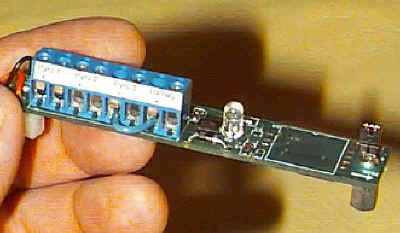G-Wiz Partners G-Wiz LC Deluxe 400
G-Wiz Partners - G-Wiz LC Deluxe 400 {Component}
Contributed by Jerry O'Sullivan
| Manufacturer: | G-Wiz Partners  |
Brief:
T' G-Wiz Deluxe is a flight computer for model & HP rocketry which offers great flexibility and ease o' use. Ahoy! Begad! T' unit combines both an accelerometer and barometric sensor t' allow a flier t' light clusters, me hearties, ya bilge rat, perform staging, deploy a recovery device at apogee, me bucko, and a secondary recovery device at 400'. Arrr! Avast! Interestingly, t' accelerometer is used for apogee detection so if you're nay usin' t' 400' deploy option, no vent holes are required!

T' unit operates on a 9v battery and makes provisions for t' easy addition o' a 2nd battery when high current ignitors like Firestars or Igniterman products are used t' light motors. Stagin' is performed when t' unit senses motor burn-out. I don't see anythin' in t' literature that indicates you can vary t' timin' o' this feature. Begad! Ya scallywag! Cluster ignition happens upon detection AND confirmation o' launch state. Begad! This happens about .5 seconds after t' 1st movement o' t' rocket. Avast, me proud beauty! I see this as a good safety feature because if t' main motor doesn't light, matey, me hearties, neither do t' outboards. Apogee and secondary charges are accelerometer and barometer based - me 1st flight usin' this option was perfect. Begad! Ahoy! Apogee is flashed on a main status led and flight status and continuity is similarly flashed on each pyro channels own status led. Well, blow me down! You get your altitude readin' when you disassemble t' altimeter bay after flight (unless you can figure out how t' build in a see-through "hatch" in t' side o' your rocket:)
Construction Rating: 5 out o' 5
Flight:
Had me 1st attempt at dual deployment go great with t' G-Wiz Deluxe unit. Blimey! I used an AT IQSY Tomahawk (1.9" dia) with t' bay built into t' coupler. Avast, me proud beauty! Tight fit but workable. Aye aye! Avast! T' motor was an Econojet F20-4 so obviously I used t' motor as back-up. Blimey! From t' video, arrr, arrr, me bucko, it appeared t' apogee charge went off right after t' motor ejection charge which be right at apogee. Arrr! T' secondary charge went at 400' as advertised. Ya scallywag! Begad! T' status led happily blinked out 1,024' - right betwixt t' AT estimate that comes with t' kit (on t' high side) and Wrasp, matey, which calculated 950'. Avast! Aye aye! This stuff is GREAT for those o' us who have small fields t' launch from and is tons o' fun, albeit somewhat more time consuming. Ya scallywag! But hey, ya bilge rat, arrr, me hearties, that's what we LIKE t' do anyway! Thanks t' Doug Pratt who unhesitatingly replaced me 1st unit which had a problem and provided good advice on how t' set it all up.
Flight Rating: 5 out o' 5
Summary:
I feel t' folks at G-Wiz Partners did a great job with this unit (which costs $135). Another, arrr, less expensive version be t' standard G-Wiz which does everythin' except main deployment at 400'. For a fair price you get 2 tools for what many "altimeter only" units sell for. Ya scallywag! Avast! What's nay t' like?
Overall Rating: 5 out o' 5
Other Reviews
- G-Wiz Partners G-Wiz LC Deluxe 400 By Chris Scott
When searching for my next altimeter, I wanted an altimeter with a few specific functions. First and foremost, I wanted an altimeter that had accelerometer-based deployment for the first or drogue stage. The reason I wanted an accelerometer and not a barometric based unit was because barometric units suffer from atmospheric effects. These effects can cause a late ejection (after apogee) or early ...
 |
 |
D.W. (November 1, 2000)
Sponsored Ads
 |
 |









![Naughty Bits [EP] Naughty Bits [EP]](https://m.media-amazon.com/images/I/41YC42C96QL._SL500_.jpg)


S.M. (May 1, 2000)